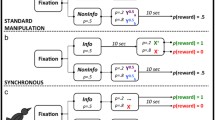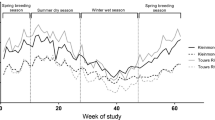Abstract
Natural selection is often envisaged as the ultimate cause of the apparent rationality exhibited by organisms in their specific habitat. Given the equivalence between selection and rationality as maximizing processes, one would indeed expect organisms to implement rational decision-makers. Yet, many violations of the clauses of rationality have been witnessed in various species such as starlings, hummingbirds, amoebas and honeybees. This paper attempts to interpret such discrepancies between economic rationality (defined by the main axioms of rational choice theory) and biological rationality (defined by natural selection). After having distinguished two kinds of rationality we introduce irrationality as a negation of economic rationality by biologically rational decision-makers. Focusing mainly on those instances of irrationalities that can be understood as exhibiting inconsistency in making choices, i.e. as non-conformity of a given behaviour to axioms such as transitivity or independence of irrelevant alternatives, we propose two possible families of Darwinian explanations that may account for these apparent irrationalities. First, we consider cases where natural selection may have been an indirect cause of irrationality. Second, we consider putative cases where violations of rationality axioms may have been directly favored by natural selection. Though the latter cases (prima facie) seem to clearly contradict our intuitive representation of natural selection as a process that maximizes fitness, we argue that they are actually unproblematic; for often, they can be redescribed as cases where no rationality axiom is violated, or as situations where no adaptive solution exists in the first place.

Similar content being viewed by others
Notes
The lack of cognitive abilities in many of the species studied does not prevent to talk about rational decisions, provided that rationality is defined in terms of behavioral outcomes rather than reasons for behaving.
In this latter case, however, we need to assume phenotypic plasticity,—understood as the ability to adjust one’s behaviour to some relevant aspects of one’s environment. For, surely, an organism deprived of any form of agency wouldn’t be properly envisaged as “rational” (or “irrational”) in the first place. Phenotypic plasticity is actually pervasive among animals and plants (West-Eberhard 2005), so this assumption should not be (presumably) very onerous.
Notice that behavioural ecologists do not directly track the fitness function of organisms when they study a given behaviour. They select a variable that is arguably a good proxy for fitness: it can be net energy intake, gross energy intake, in some cases metabolism rates, or more general measures such as inclusive fitness (Davies et al. 2012).
Ecological rationality corresponds in biology to what behavioural economists call “bounded rationality” after Herbert Simon.
Far from contrasting with B-rationality, ecological rationality actually encompasses it: it is underdetermined given that it centers on a utility function defined by a task on which the modeler focuses; and when this task is fitness, it coincides with B-rationality.
Error management theory explains why people avoid drinking in sterile glasses that are used to contain urine samples—as a clear case of overestimating a threat. A prediction would be that, when people prefer, let’s say, green glasses over red glasses, when faced with ternary choice that includes urine sample glass, they would chose red or green glasses stochastically (“any glass is better than the urine glass” being the underlying rationale) and show preference reversal in the face of added independent alternatives.
For related studies, see Houston (1997).
A paradigmatic example of aggregate risk is weather: indeed, if a population of individuals opt (say) for a wet-specialized strategy, then all of them will suffer an equal fitness loss in a dry year (and, equally, an equal fitness gain in a wet year). By contrast, a good example of an idiosyncratic risk is predation risk: indeed, in most cases, being caught by a predator does not imply that another individual with the same behaviour will also be caught by a predator.
If the risk has both an idiosyncratic and an aggregate component, things are different, as we will see in the next section.
More precisely, this is unlikely if we assume that the individuals are “playing against the field”, and not against particular individuals, as in pairwise interactions (Maynard-Smith 1982). For in this latter case, the individuals could possibly use cues or signals correlated with the behaviour of their partner to adopt the best response.
We thank an anonymous reviewer for having raised this important issue.
References
Adams, F., & Garrison, R. (2013). The mark of the cognitive. Minds and Machines, 23(3), 339–352.
Akerlof, G. A., & Shiller, R. J. (2009). Animal spirits: How human psychology drives the economy, and why it matters for global capitalism. Princeton: Princeton University Press.
Bateson, M., Healy, S. D., & Hurly, T. A. (2002). Irrational choices in hummingbird foraging behaviour. Animal Behaviour, 63(3), 587–596.
Birch, J. (2015). Natural selection and the maximization of fitness. Biological Reviews, 91(3), 712–727.
Bossert, W., & Suzumura, K. (2011). Rationality, external norms, and the epistemic value of menus. Social Choice and Welfare, 37(4), 729–741.
Camerer, C. (2003). Behavioural game theory: Experiments in strategic interaction. New York: Princeton University Press.
Cosmides, L., & Tooby, J. (1997). Dissecting the computational architecture of social inference mechanisms. In G. Bock & G. Cardew (Eds.), Characterizing human psychological adaptations (Ciba Symposium Volume #208) (pp. 132–158). Chichester: Wiley.
Curry, P. A. (2001). Decision making under uncertainty and the evolution of interdependent preferences. Journal of Economic Theory, 98(2), 357–369.
Davies, N. B., Krebs, J. R., & West, S. A. (2012). An introduction to behavioural ecology. Hoboken: Wiley-Blackwell.
Gigerenzer, G. (1998). Ecological intelligence: An adaptation for frequencies. In D. Cummins & C. Allen (Eds.), The evolution of mind (pp. 9–29). New York, NY: Oxford University Press.
Gigerenzer, G., Todd, P. M., & The ABC Research Group. (1999). Simple heuristics that make us smart. New York: Oxford University Press.
Gould, S. J., & Lewontin, R. C. (1979). The spandrels of San Marco and the Panglossian paradigm: A critique of the adaptationist programme. Proceedings of the Royal Society of London B: Biological Sciences, 205(1161), 581–598.
Grafen, A. (1999). Formal Darwinism, the individual-as-maximizing-agent analogy and bet-hedging. Proceedings of the Royal Society of London B: Biological Sciences, 266(1421), 799–803.
Hammerstein, P. (2002). Evolutionary adaptation and the economic concept of bounded rationality—a dialogue. In G. Gigerenzer & R. Selten (Eds.), Bounded rationality. The adaptive toolbox (pp. 73–82). Cambridge: MIT Press.
Haselton, M. G., & Buss, D. M. (2000). Error management theory: A new perspective on biases in cross-sex mind reading. Journal of Personality and Social Psychology, 78(1), 81–91.
Haselton, M. G., & Buss, D. M. (2009). Error management theory and the evolution of misbeliefs. Behavioral and Brain Sciences, 32(6), 522–523.
Houston, A. I. (1997). Natural selection and context-dependent values. Proceedings of the Royal Society B, 264, 1539–1541.
Houston, A. I. (2012). Natural selection and rational decisions. In S. Okasha & K. Binmore (Eds.), Evolution and rationality: Decisions, cooperation and strategic behaviour (pp. 50–66). Cambridge: Cambridge University Press.
Houston, A. I., McNamara, J. M., & Steer, M. D. (2007). Do we expect natural selection to produce rational behaviour? Philosophical Transactions of the Royal Society of London B: Biological Sciences, 362(1485), 1531–1543.
Hurly, T. A., & Oseen, M. D. (1999). Context-dependent, risk-sensitive foraging preferences in wild rufous hummingbirds. Animal Behaviour, 58(1), 59–66.
Kacelnik, A. (2006). Meanings of rationality. In S. L. Hurley & M. Nudds (Eds.), Rational animals (pp. 87–106). Oxford: Oxford University Press.
Kahneman, D. (2011). Thinking, fast and slow. New York: Macmillan.
Kahneman, P. Slovic, & Tversky, A. (Eds.). (1982). Judgment under uncertainty: Heuristics and biases. Cambridge: Cambridge University Press.
Latty, T., & Beekman, M. (2011). Irrational decision-making in an amoeboid organism: Transitivity and context-dependent preferences. Proceedings of the Royal Society of London B: Biological Sciences, 278(1703), 307–312.
MacArthur, R. H., & Pianka, E. R. (1966). On optimal use of a patchy environment. American Naturalist, 100(916), 603–609.
Machina, M. J. (1989). Dynamic consistency and non-expected utility models of choice under uncertainty. Journal of Economic Literature, 27(4), 1622–1668.
Maynard-Smith, J. (1982). Evolution and the theory of games. Cambridge: Cambridge University Press.
McNamara, J. M. (1995). Implicit frequency dependence and kin selection in fluctuating environments. Evolutionary Ecology, 9(2), 185–203.
McNamara, J. M., Trimmer, P. C., & Houston, A. I. (2014). Natural selection can favour ‘irrational’ behaviour. Biology Letters, 10(1), 20130935.
Moran, P. A. P. (1964). On the non-existence of adaptive topographies. Annals of Human Genetics, 27(4), 383–393.
Nesse, R. M. (2005). Natural selection and the regulation of defenses: A signal detection analysis of the smoke detector problem. Evolution and Human Behavior, 26, 88–105.
Okasha, S. (2011). Optimal choice in the face of risk: Decision theory meets evolution. Philosophy of Science, 78(1), 83–104.
Robson, A. J. (1996). The evolution of attitudes to risk: Lottery tickets and relative wealth. Games and Economic Behavior, 14(2), 190–207.
Robson, A. J., & Samuelson, L. (2010). The evolutionary foundations of preferences. In J. Benhabib, A. Bisin & M. Jackson (Eds.) Handbook of social economics (Vol. 1B, pp. 221–310). Amsterdam: North Holland.
Schuck-Paim, C. (2003). The Starling as a rational decision-maker. Oxford: University of Oxford.
Sen, A. (1993). Internal consistency of choice. Econometrica: Journal of the Econometric Society, 61(3), 495–521.
Sen, A. (1997). Maximization and the act of choice. Econometrica: Journal of the Econometric Society, 65(4), 745–779.
Shafir, S. (1994). Intransitivity of preferences in honey bees: Support for ‘comparative’ evaluation of foraging options. Animal Behaviour, 48(1), 55–67.
Stearns, S. C. (1992). The evolution of life histories. Oxford: Oxford University Press.
Tversky, A., & Kahneman, D. (1982). Judgments of and by representativeness. In D. Kahneman, P. Slovic, & A. Tversky (Eds.), Judgment under uncertainty: Heuristics and biases. Cambridge: Cambridge University Press.
Tversky, A., & Shafir, E. (1992). Choice under conflict: The dynamics of deferred decision. Psychological Science, 3(6), 358–361.
von Neumann, J., & Morgenstern, O. (1944). Theory of games and economic behavior. Princeton: Princeton University Press.
West-Eberhard, M. J. (2005). Phenotypic accommodation: Adaptive innovation due to developmental plasticity. Journal of Experimental Zoology Part B: Molecular and Developmental Evolution, 304(6), 610–618.
Acknowledgements
The authors thank two anonymous reviewers for their useful comments, as well as the Evo-Eco group in Paris for helpful discussions of the views presented in this paper. This work is supported by the ANR Grant 13-BSH3-0007 Explabio.
Author information
Authors and Affiliations
Corresponding author
Rights and permissions
About this article
Cite this article
Huneman, P., Martens, J. The behavioural ecology of irrational behaviours. HPLS 39, 23 (2017). https://doi.org/10.1007/s40656-017-0150-5
Received:
Accepted:
Published:
DOI: https://doi.org/10.1007/s40656-017-0150-5




